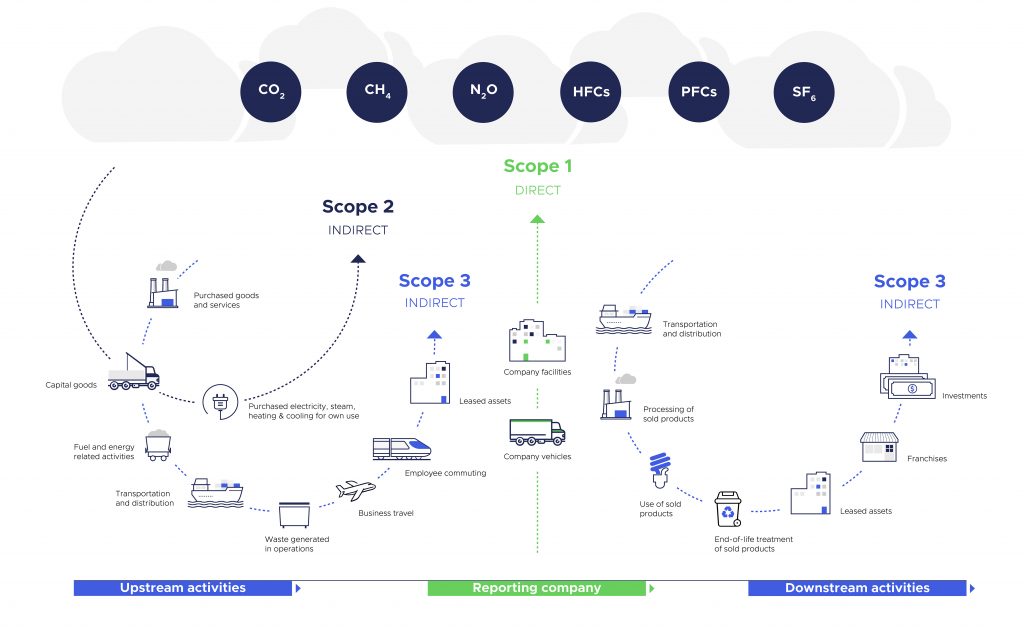
Scope 1, 2, and 3 emissions are categories used to define and quantify sources of greenhouse gas emissions produced by a company or organization. These emissions are an essential metric in measuring a business’s environmental impact and are critical to the development of strategies to mitigate climate change.
The concept of Scope 1, 2, and 3 emissions were created by the Greenhouse Gas Protocol, a widely-used accounting tool for managing and reporting greenhouse gas emissions. It was developed through a collaboration between the World Resources Institute and the World Business Council for Sustainable Development in 1998 and first published its standards in 2001.
Since then, Scope emissions have become the most well-known and widely followed metrics by which organizations measure their carbon emissions, and are essential when it comes to reporting for carbon trading or ESG filing.
Scope 1: direct emissions
Scope 1 emissions are the direct emissions a company produces. These are emissions that come directly from sources owned or controlled by the company, such as emissions from burning fossil fuels to generate electricity, heat, or power vehicles. These types of emissions are under the direct control of the company. As such, the company is responsible for taking direct action to reduce or eliminate them.
The amount of Scope 1 emissions a company produces depends on factors like fuel type, energy consumption, and transportation activity. Companies with significant energy consumption and transportation activities are likely to have higher levels of Scope 1 emissions compared to companies with limited energy and transportation needs.
Scope 2: indirect emissions
Scope 2 emissions are indirect emissions that result from the consumption of purchased electricity, heat, or steam by a company. These emissions come from electricity providers, not the company itself.
However, a company’s decisions can still have an impact on them. For example, a company can reduce its Scope 2 emissions by purchasing renewable energy, investing in energy efficiency, or reducing energy consumption.
Factors that influence Scope 2 emissions include:
- The source of electricity: the type of energy used to produce electricity, such as coal, natural gas, or renewable energy
- Energy consumption: the amount of energy a company uses directly affects the Scope 2 emissions it produces.
- Renewable energy sources: purchasing renewable energy, such as wind, solar, or hydropower instead of non-renewable sources
- Energy efficiency: investing in energy-efficient technologies and practices, such as upgrading lighting and HVAC systems
- Location: the location of a company also affects its Scope 2 emissions, as the mix of energy sources used to produce electricity varies from region to region, as does the climate
Scope 3 emissions: value chain emissions
Scope 3 emissions refer to all indirect greenhouse gas emissions that are not included in scope 1 or 2. These emissions result from activities that are associated with a company’s value chain but occur outside of the company’s own operations, such as the extraction and production of purchased materials, transportation and distribution, product use, and end-of-life treatment of sold products.
Scope 3 emissions are generally the largest source of emissions for most companies, and they can be difficult to measure and manage because they involve many actors and activities outside of a company’s direct control.
However, once the challenge of measuring scope 3 emissions is overcome, there are options for reducing them. For example, a company can opt for a more sustainable transportation method, such as rail or water shipping, instead of air transportation. It may also require choosing new suppliers since the actions of your partners contribute to scope 3.

Corporate carbon footprints and climate change
Greenhouse gas emissions are one of the leading causes of climate change and have a significant impact on the environment. They trap heat in the atmosphere, causing the planet to warm, which leads to changes in weather patterns, rising sea levels, and increased frequency and intensity of extreme weather events.
By measuring and reducing their scope 1, 2, and 3 emissions, companies can reduce their carbon footprint and help mitigate the effects of climate change. This can also have a positive impact on their reputation, as consumers and investors are becoming increasingly concerned about the environmental impact of the products and services they purchase. Companies that are seen as environmentally responsible can benefit from increased customer loyalty and improved brand image.
In addition, reducing emissions can also have financial benefits for companies. Investing in renewable energy and energy efficiency can reduce operating costs, and companies can also take advantage of government incentives, such as green financing, by reducing emissions. Furthermore, companies can also generate revenue by selling carbon credits on carbon markets.
Why does this matter for ESG?
Scope 1, 2, and 3 emissions are critical indicators of a company’s impact on the environment, and are therefore a central component of ESG analysis. As sustainability becomes more of a factor in purchasing decisions, and ESG becomes the gold standard for investors and regulators, companies that are proactive in reducing their emissions and adopting sustainable business practices will likely see improved investor sentiment, customer loyalty, and overall financial performance.
Companies that have a strong ESG profile, including low emissions, are well-positioned to comply with future regulations, avoid potential penalties or reputational damage, and meet the growing demand for environmentally responsible products and services.
What can companies do about their scope 1, 2, and 3 emissions?
In the case of Scope 1, 2, and 3 emissions, knowing is half the battle. By understanding how they are producing these emissions, companies can take meaningful action to reduce them. Many organizations rely on external auditors and consultants to help measure and collect this data, but this can be time-consuming and expensive. Other organizations have some information on their energy use thanks to certain software like an Energy Management System (EMS), but the data is often time unclear and disconnected.
Akila is the best of both worlds: fully automated data collecting on all aspects of emissions, visualized in the digital twin. It does much more than an EMS, which just looks at energy use, and it enables organizations to see their data without the need for lengthy and complicated data collection processes which often require consulting.
For example, when we deploy Akila for clients looking to measure their carbon footprint, we identify the sources of scope 1 or 2 carbon emissions. Then, we outfit the equipment and spaces with sensors or integrate working processes such as waste collection with a documentation system. Tracking source 3 emissions is also possible through Akila by integrating supplier-based data.
All data is fed in real-time into the digital twin platform, not only providing a data stream but also creating a single source of truth on the facility or portfolio-wide operations to see where (and when) emissions are being created. Akila can take this data to the next level with simulation and AI, modeling how systems or equipment would perform in different scenarios or even interchanged entirely for new assets. From there, decision-makers can begin to strategize how to best act to reduce emissions.
Reducing emissions is not only crucial in the fight against climate change, but it also improves the reputation and bottom line. Organizations that are proactive in reducing their emissions will be well-positioned to succeed in the coming years to meet the demand to deliver environmentally responsible products and services.







